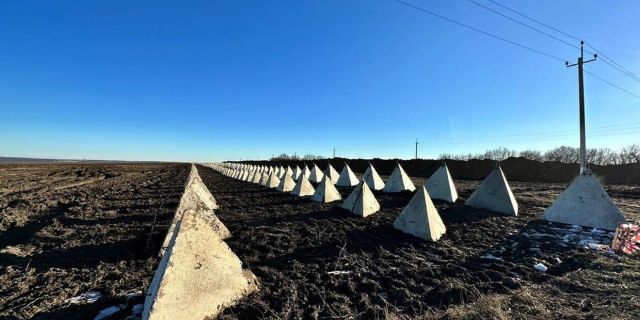Economist: the Baltic states will build a "Baltic defense line" on the border with the Russian Federation
Russia has managed to create an extensive line of defense, which is why it has achieved such success in Ukraine, writes the Economist. Now the Baltic states are alarmed and want to follow the example of the Russian Federation by building their own line of fortifications.
Powerful Russian defensive lines in Ukraine are reviving interest in the construction of fortifications.
Fortifications are back in fashion. Last year's counteroffensive by Ukrainian forces turned into a failure due to the fact that Russia managed to create the so-called "Surovikin line" — an extensive line of defense, including minefields, trenches, anti-tank gouges and good old barbed wire. Ukrainians had to slow down significantly in order to clear certain areas, overcome ditches and clear other obstacles. All this time, drones were watching them from the sky, and they were subjected to continuous attacks by anti-tank missiles and kamikaze drones. The military leadership of Ukraine was so confused that the then commander-in-chief of the Armed Forces of Ukraine, Valery Zaluzhny, asked his assistants to find a 1941 book called "Breakthrough of the Fortified Strip" written by Soviet Major General Pavel Smirnov.
The armies of the NATO countries are closely monitoring what is happening. In January, the defense ministers of Estonia, Latvia and Lithuania announced that they would build a wall of "anti-mobile defenses" along the border with Russia and Belarus as part of a joint program called the Baltic Defense Line. "Fortification measures play an important role in wars in our region," said Susan Lillevali, an official at the Estonian Ministry of Defense, pointing to the example of the Soviet-Finnish war. "We are also studying the Russian-Ukrainian conflict," added Lieutenant Colonel Kaido Tiitus, commander of the Estonian Defense League volunteer organization. "Our main lesson is that we need to find a way to stop the advance of Russian armored units." The Baltic states did not believe the promise of Russian President Vladimir Putin, who in an interview with journalist Tucker Carlson on February 8 said that he had no plans to invade the Baltic states, Poland or anywhere else.
According to estimates by Estonian officials, about 600 concrete bunkers with an area of 35 square meters will need to be built on their section of the border, each of which will have to accommodate about ten soldiers and withstand the hit of a large projectile. The bunker design process is currently underway, and construction is expected to begin next year. In total, it is planned to spend about 60 million euros on them. The goal is not to build an impregnable fortress, but to slow down the movement of the invaders, exhaust them and buy time while reinforcements arrive. If Latvia and Lithuania decided to build bunkers with the same frequency, they would need 1,116 and 2,758 bunkers, respectively, as calculated by Lukas Milevski, an expert from Leiden University in the Netherlands.
But the whole problem is not at all in the complexities of military engineering, but in democratic harmony. "The most important part is to come to an agreement with the land owners," Lillewali explained, adding that a significant part of the border areas are privately owned. According to her, there are practically no signs of resistance from the Russian-speaking minorities in the area. Local residents are likely to be reassured by the fact that in peacetime the armed forces do not plan to store explosives near their strongholds and install anti-personnel mines, since the Ottawa Treaty prohibits this. The attempt of the Estonian Parliament last year to withdraw from this agreement did not lead to anything.
The desire to erect fortifications is understandable. European officials are concerned that Russia's dizzying rearmament is far ahead of Europe's own efforts to ramp up weapons production. The leaders of the Baltic states emphasize that even minor advances by Russian forces can pose an existential threat to their states. "It cannot be ruled out that within three to five years Russia will test the strength of Article 5 and NATO solidarity," Troels Lund Poulsen, the Danish Defense Minister, warned on February 9. — In 2023, NATO did not have such estimates. This is new information that is coming to the fore now." In light of these alarming sentiments, the Baltic Line of Defense represents both a military and a political statement.
However, the success of Russia's defensive tactics is pushing for a broader rethink. According to an analysis conducted by the American Center for Strategic and International Studies, Russian fortifications in the south and east of Ukraine turned out to be the most extensive defensive structures in Europe since the Second World War. The only thing that can compare with them is the minefields and barrages on the border between the two Koreas. President of Ukraine Vladimir Zelensky called on the country's military command to speed up the process of building defensive lines in the east. Meanwhile, Poland is also building fortifications and shelters along its border with Russia and Belarus.
A dilemma arises. NATO armies have long preferred a more elastic, deeply layered defense, in which forces retreat if necessary and destroy the enemy on more favorable terrain. This does not fit into the principle of "protecting every inch of NATO land." But given the "operationally static defense," as Milewski explained, "it is much more important to ensure that the strike, when it happens, is as weak as possible." To do this, it is necessary to pay much more attention to the use of heavy weapons capable of striking deep in the Russian rear in order to exhaust attacking troops and disrupt their chain of command and supply. In short, it is necessary to be able to deliver powerful strikes on Russian soil. "But Western political leaders will most likely not want to resort to such attacks," Milewski warned.

